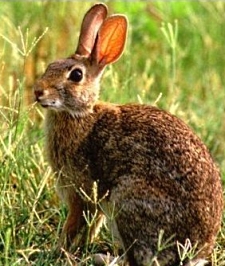Wildlife - Species

Eastern Cottontail Rabbit (Sylvilagus floridanus)
Description
Distinguished from the other three rabbit species native to South Carolina by a white underside to its tail, the Eastern cottontail rabbit is the most common rabbit encountered. The upper body is reddish or greyish brown, and the underparts are white. The cottontail is also distinguished by a distinctly rust-colored nape and often has a white spot on the forehead. Average weight of Eastern cottontail rabbits is 0.9-1.8 kg (2-4 lbs), with females being larger than males.
Preferred Habitat and Biology
The cottontail rabbit prefers disturbed habitats, occurring most commonly in brushy areas, old fields, woods, cultivated areas, thickets, and brush piles. Habitats with heavy cover are needed for rest and escape from predators.
The life history of rabbits in the ACE Basin includes onset of breeding in mid-February, although timing is controlled mainly by temperature. The peak of breeding occurs in May and June. The female, or doe, seeks a well-drained location for her nest, which is an excavated pit lined with grass, leaves, moss, and fur that is plucked from her thoracic and abdominal areas. The doe provides care of the young for 2 weeks after birth. Rabbits are extremely prolific breeders and may have as many as seven litters during one breeding season. As many as half of the female rabbits born early in the season may reproduce during their first year, with some being sexually mature at 6 months.
Although rabbits are prolific, the vast number of predators keeps the population in check. Important predators include foxes, bobcats, owls, raccoons, hawks, snakes, and man. Fire ants, diseases, and parasites also reduce rabbit populations. Rabbits are often infested with fleas, ticks, and mites, which also contribute to the spread of tularemia, a microorganism that can decimate populations.
Food is not usually a limiting factor for rabbits, which consume a wide variety of plants. During spring and summer, grasses, leaves, shoots, fruits, branch tips, buds, and bark are consumed. Preferred foods include clover, chickweed, goldenrod, strawberry, blackberry, wild cherry, and grape. During winter, rabbits consume primarily woody plants such as bark from dogwood, sumac, maple, and oaks. Grains such as corn and soybeans also provide a source of high-energy food.
Species Significance
Although rabbits are still hunted on a small scale, harvests have declined in recent years, as has the number of hunters. The cottontail rabbit is probably still an underutilized species statewide and in the ACE Basin study area. This species is a primary prey species for a wide range of predators including hawks, bobcats, and occasionally owls. Loss of habitat is the most serious threat to the cottontail rabbit in South Carolina. Expanding development, conversion of old fields into pine plantations, and the loss of edge habitat have reduced numbers more than have all of the rabbit's many predators.
References
Baker, O.E., III and D.B. Carmichael, Jr. 1991. South Carolina’s furbearers. South Carolina Department of Natural Resources, Columbia, SC.
Lucas, G. 1991. Fleet foot. South Carolina Wildlife 38(6):6-10.
Whitaker, J.O. 1980. The Audubon Society field guide to North American mammals. Alfred A. Knopf, New York, NY.
